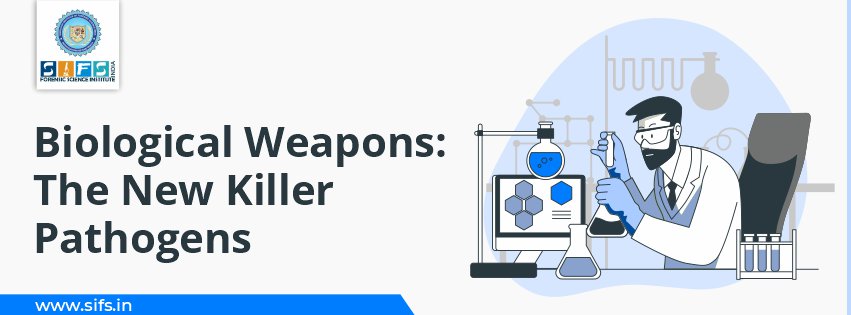- Call Us: +91 7303913002
- Email Us: education@sifs.in
Biological Weapons: The New Killer Pathogens

BY SIFS India | January 25, 2025
Biological Weapons: The New Killer Pathogens
Nowadays, different ways of committing a crime or harming someone have been frequently used.
A biological weapon is a pathogenic microbe or toxins which are produced by some microbes but also include their carriers like insects, rodents, ticks etc., used with the intention to injure people, animals, plants and food supplies as well as the means with which these are applied.
A pathogen is an organism that cause disease.
Microbes are classified on the basis of their structure and characteristics into bacteria, viruses, rickettsia and fungi. Toxins are highly active poisons produced by some microbes, which cause dangerous effects when they attack the human body, animals and plants.
Killer pathogens Likely to be used in Biological Warfare
Against Human Beings
Bacteria
- Bacillus Anthracis (Anthrax)
- Salmonella Typhose (Typhoid)
- Pasteurella Pestis (Plague)
- Vibric Comma (Cholera)

Figure 1 - Anthrax Bacteria
Viruses
- Influenza Virus (Influenza)
- Virus of infectious Hepatitis (Jaundice)
- Variola Virus (Small Pox)

Figure 2 - Influenza Virus
Rickettsia
- Rickettsia Prowazeki (Epidemic Typhus)

Figure 3 - Pediculus Humanus Corporis
Toxins
- Botulinum Toxin (Botulism)
- Staphylococous Toxin (Food Poisoning)
Against Animals
Bacteria
- Bacillus Anthracis (Anthrax)
- Brucella Group (Brucellosis)
Viruses
- Foot and mouth disease virus
- Rinderpest Virus (Cattle Plague)
Against Plants and Crops
- Helminthosporium oryzae (Against Rice)
- Piricularia oryzae (Against Rice)
- Corynelacterium sepedonicum (Against Potato)
Characteristics
The organisms produced by hundreds of diseases could be used as biological agents but the organism must satisfy certain conditions for effectiveness against the enemy. The conditions are:
Virulence: For the germ it is necessary to be virulent so that even small doses produce infection.
Power to Produce Disability: The capability of producing diseases even to the extent of causing death or prolonged incapacitation by a germ is essential. In case of crops the germ must cause considerable damage to crops.
Stability: The ordinary conditions of light, heat and humidity should not make the germ unstable. The germ must be capable of withstanding destruction and retain its virulence. It should also possess the qualities of storage capability and withstanding the explosion by which the organisms might be liberated from a bomb.
Resistance of People: The population on which it is to be let loose must be susceptible to the disease with little means of immunity against the same.
Transmissibility: The germ should also possess the quality of dissemination by a convenient manner e.g. by air or through water, milk or food etc.
6. Availability: The germ must be capable of mass production.
The following table shows Primary Infectious Pathogens which may be used by the Enemy as Biological Bombs
Table no. 1 - Biological Infections Pathogen
|
Type of Pathogens |
Mean incubation
(days) |
Contagiousness |
Observation period
(days) |
Quarantine period and
conditions |
|
Bubonic plague |
1-3 |
Very dangerous |
8 |
6 days |
|
Anthrax |
1-3 |
Not very dangerous |
6 |
8 days in an epidemic &
infection by contact |
|
Rabbit fever |
3-6 |
Not dangerous |
14 |
Not applicable |
|
Sprious glander (melioidosis) |
2-3 |
Dangerous |
14 |
14 days in an epidemic &
infection by contact |
|
Malleomyces |
2-3 |
Dangerous |
14 |
Same |
|
Cholera |
1-3 |
Very dangerous |
|
6 days |
|
Botulism toxin |
2-24 |
Not dangerous |
2 |
Not applicable |
Table no. 2 - Rickettslosis PathogenXVFB
|
Type of Pathogens |
Mean incubation
(days) |
Contagiousness |
Observation period
(days) |
Quarantine period and
conditions |
|
Exanthematous
pathogens |
10-14 |
Dangerous
with pediculosis |
23 |
23
days under epidemic conditions with pediculosis |
|
Q
fever |
10-20 |
Not
dangerous |
26 |
Not
applicable |
|
Rocky
mountain fever |
3-10 |
Not
dangerous |
14 |
Same |
Table no. 3 - Virus Infection Pathogen
|
Type of Pathogens |
Mean incubation
(days) |
Contagiousness |
Observation period
(days) |
Quarantine period and
conditions |
|
Smallpox |
13-14 |
Very dangerous |
|
17 days |
|
Equine encephalomyelitis |
2-10 |
Not dangerous |
21 |
Not applicable |
|
Yellow fever |
3-6 |
Dangerous in the presence of
mosquito vectors |
12 |
12 days under epidemic conditions
and in the presence of mosquito vectors |
|
Psittacosis |
8-15 |
dangerous |
15 |
15 days only in case of epidemic
& with contact contagion |
Table no. 4 - Mycosis Pathogen
|
Type of Pathogens |
Mean incubation
(days) |
Contagiousness |
Observation period
(days) |
Quarantine period and
conditions |
|
Coccidioidomycosis |
10-14 |
Not dangerous |
15 |
Not applicable |
Types of Biological Agents
The biological warfare agents likely to be used would be of one of the known type of disease producing germs. Like chemical agents these could be classified as persistent and non-persistent.
Persistent Agents: These are spore bearing germs and like a seed, can lie dormant for long period, e.g. spores of Anthrax. These are comparatively few and have more resistant power.
Non-Persistent Agents: These are non-spore bearing and consequently tend to die rapidly under adverse conditions.
Methods of Employing Biological Bombs
The most probable method might be to contaminate the layers of the atmosphere near the ground with aerosols in the form of liquid or dry bacterial compounds with a view to infect everyone in the zone of its application, by making it possible to disperse agents of almost all infectious diseases even those which are not transmitted through the air under ordinary conditions e.g. brucellosis, typhus, yellow fever, etc.
The contamination of people, animals and surrounding objects occur not only at the moment of biological attack, but for a long time afterward. Rockets, airborne bombs, artillery shells and mines, packets, bags, boxes, containers etc. thrown from aeroplanes, special equipment or spraying or vaporizing and sabotage for contaminating air, water and places may be applied for the use of biological weapons with the object to:
- Lowering morale and creation of panic;
- Incapacitation of selected groups of population such as industrial and defence workers, etc.;
- As a part of general attack on the population; and
- In order to create food shortage through attack on crops and livestock.
Detection of Biological Weapon Attack
The bomb used for biological warfare purposes may look similar to a gas bomb and on bursting would slowly give out spray or a mist or liquid which may or may not be visible. Some key points for the detection of a biological weapon attack:
- Usually irregular lines of band of smoke or fog in the wake of moving aircraft are visible;
- Microbe- carrying weapon gives a dull sound of explosion;
- Special aerial bombs, shells or various containers are noticed on terrain;
- Drops of liquid or powdery substances on the soil or other objects become visible;
- Keeping in view the place or season, the unusual appearance of hosts of insects, mites or rodents;
- People and animals are severely affected by epidemic diseases.
Written by: Shally Chauhan

